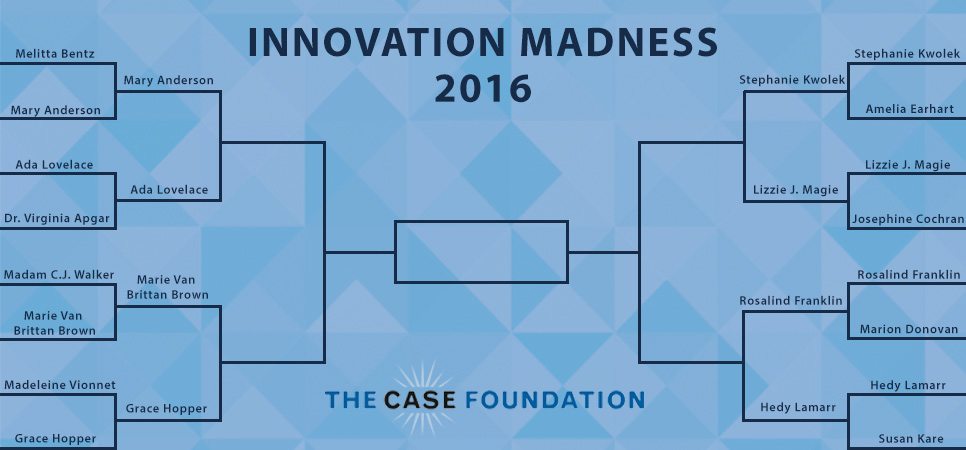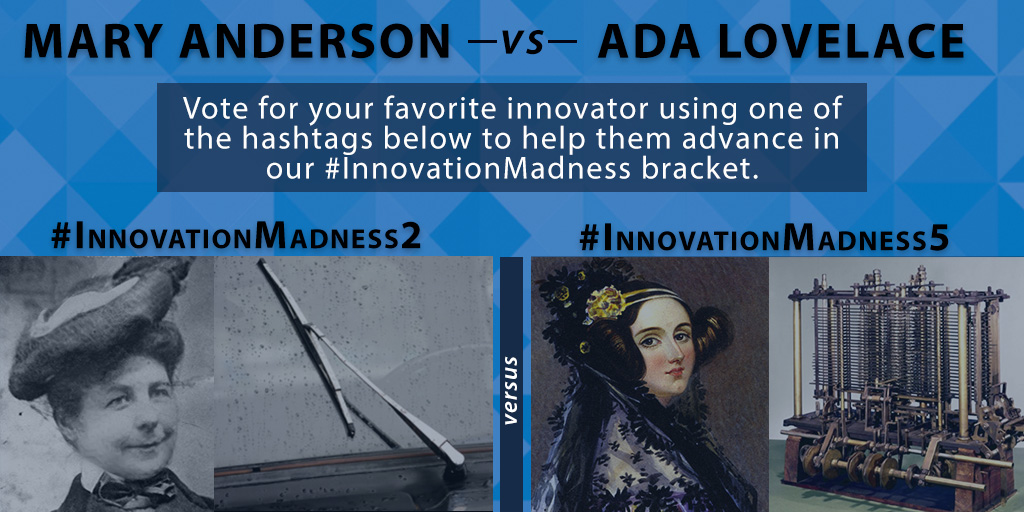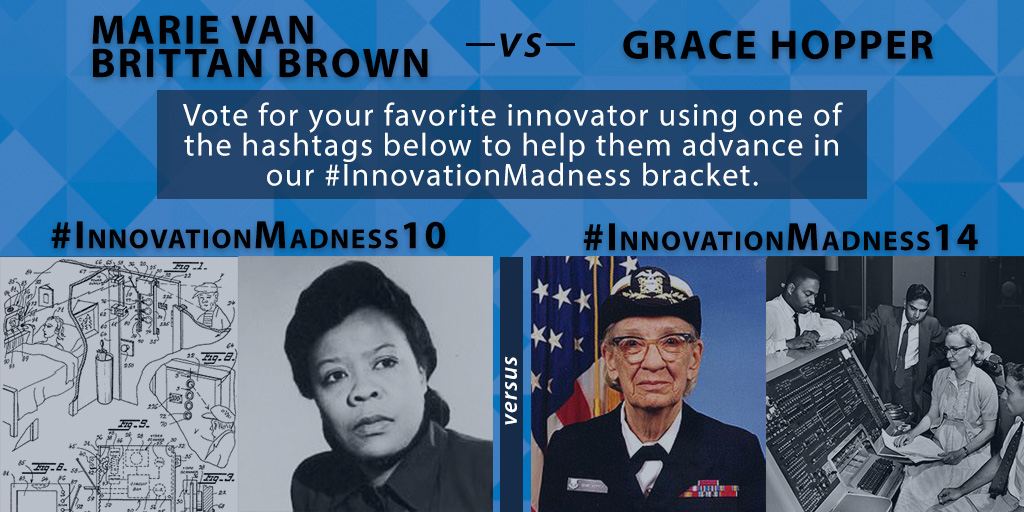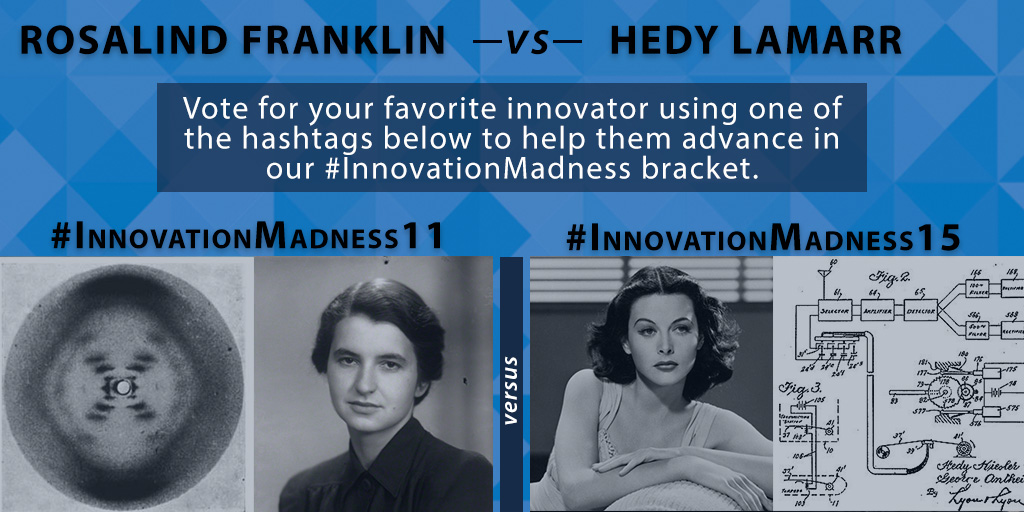Thank you to everyone who has voted in our Innovation Madness! We are thrilled to be highlighting these incredible women innovators and having a little fun with this bracket at the same time. Thanks to all of your voting, we have narrowed down our original Sweet 16 innovators to the Elite Eight. You can see the bracket progress below and the new matchups. Please continue to vote on Twitter for your favorites and keep telling us why you love these fearless women!
Also, if you’re only now tuning in, we invite you to check out our original post explaining more about Innovation Madness and how we’re celebrating Women’s History Month to help recognize the remarkable women who have been influential innovators in exploration, business and the STEM fields—yet are sometimes not recognized as often as their male counterparts.

MATCHUP ONE: Mary Anderson VS. Ada Lovelace

#InnovationMadness2: Mary Anderson, inventor of windshield wipers
Chosen by Julia Power, Office Coordinator
There are about 253 million cars and trucks on U.S. roads today. Before Anderson’s 1903 invention of the windshield wiper, drivers would have to stop their car every few minutes to physically wipe the buildup from their windshield. Not only was this inefficient, but it was also extremely dangerous! Anderson’s invention has been helping drivers with their commutes ever since.
Vote for Mary Anderson by tweeting #InnovationMadness2.
Versus:
#InnovationMadness5: Ada Lovelace, the first computer programmer
Chosen by Lauren Burton, Senior Director of Interactive Strategies
Your best friend’s latest post on your news feed. That movie you have been meaning to see suggested on your Netflix. A product recommended for you on Amazon. What do these have in common? They are powered by algorithms! You can thank Ada Lovelace, who is credited with developing the first algorithm in 1842 intended to be carried out by a machine. She is sometimes known as “the first computer programmer.”
Vote for Ada Lovelace by tweeting #InnovationMadness5.
MATCHUP TWO: Stephanie Kwolek VS. Lizzie J. Magie

#InnovationMadness3: Stephanie Kwolek, creator of Kevlar
Chosen by Coleen Walsh, Executive Assistant
Thanks to a determined Pennsylvania woman named Stephanie Kwolek, thousands of lives have been saved. In 1971 while working at DuPont as one of its only female chemists, Kwolek created a fiber called poly-paraphenylene terephthalamide—better known as Kevlar. Five times stronger than steel, this invaluable synthetic material has since been used in more than 200 applications, including safety helmets, aircraft parts, suspension bridge cables, parachutes and most notably bulletproof vests.
Vote for Stephanie Kwolek by tweeting #InnovationMadness3.
Versus:
#InnovationMadness7: Lizzie J. Magie, creator of the Monopoly game
Chosen by Sheila Herrling, Vice President of Social Innovation
In 1903, Lizzy Magie was troubled by the vast income inequality she saw, and a capitalist system that could either put private capital to public good (think early impact investing), or benefit the few already well off. She used that personal passion to invent the board game—Landlord. The original game had rules that allowed players to live and learn the tension between and tactics for pursuing the two philosophies. Many believe that this game was the inspiration for Charles Darrow, who in 1932 turned it into Monopoly and sold it to Parker Brothers. Lizzy Magie fought for its rights, received $500 for the Landlord’s patent (no royalties) and her role as true founder of the Monopoly concept continues to be debated in the history books, but you can vote her into victory here!
Vote for Lizzie J. Magie by tweeting #InnovationMadness7.
MATCHUP THREE: Marie Van Brittan Brown VS. Grace Hopper

#InnovationMadness10: Marie Van Brittan Brown, creator of the home security system
Chosen by Jade Floyd, Senior Director of Communications
Today’s home security systems feature all the bells and whistles, from infrared cameras to home automation technology to electronic control of every light and lock. But did you know that the first modern-day home security closed-circuit television system (CCTV), alarm and entry buzzer to allow guests in was invented by Marie Van Brittan Brown in 1966? An uptick in crime in her neighborhood drove her to create the system so she would feel safer while at home alone. She invented the remote monitor and control-operated door that laid the groundwork for a now multi-billion dollar market.
Vote for Marie Van Brittan Brown by tweeting #InnovationMadness10.
Versus:
#InnovationMadness14: Dr. Grace Murray Hopper, inventor of the first computer compiler
Chosen by Brian Sasscer, Senior Vice President of Strategic Operations
Dr. Grace Murray Hopper (a U.S. Navy Rear Admiral) co-designed Harvard’s Mark 1 computer in 1944. She also invented the first computer compiler, which translated written language into computer code. As if that wasn’t enough, she helped lead the development of COBOL—one of the first user-friendly programming languages. FUN FACT—she is credited with making popular the terms “bug” and “debug” to describe a computer glitch—which in this case happened to be an actual moth in the computer. No wonder she is sometimes referred to as #AmazingGrace.
Vote for Dr. Grace Murray Hopper by tweeting #InnovationMadness14.
MATCHUP FOUR: Rosalind Franklin VS. Hedy Lamarr

#InnovationMadness11: Rosalind Franklin, contributor to DNA structure discovery
Chosen by Molly Porter, Senior Project Manager
Rosalind Franklin was a pioneer in molecular biology and chemistry. Her work in x-ray diffraction techniques of DNA was a catalyst in the understanding of the structure of DNA. While her contributions to the scientific community were largely unrecognized or misattributed to other scientists during her lifetime, her discoveries unleashed endless potential for greater understanding of DNA and genetics for further generations of scientists.
Vote for Rosalind Franklin by tweeting #InnovationMadness11.
Versus:
#InnovationMadness15: Hedy Lamarr, creator of spread spectrum technology
Chosen by Fatimah Shaikh, Social Innovation Intern
Hedy Lamarr was not only a 1930s movie star, she also gave us an invention that still stands at the forefront of technology even today: the spread spectrum. With the help of Georg Antheil, an experimental musician, Lamarr invented the Secret Communications System, which they tried to give to the U.S. military during WWII. However, it was not until the Cuban Missile Crisis that the value of spread spectrum was realized. Today, Lamarr’s Secret Communication System is the backbone of all technological machines with wireless operations.
Vote for Hedy Lamarr by tweeting #InnovationMadness15.










